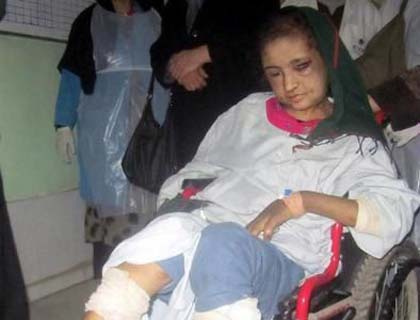Another shocking example of violation against women and negative impacts of child bride in Afghanistan cropped up last week when Afghan police rescued a 15 year old girl, Sahar Gul, who was beaten inhumanely and locked up for five months in a lavatory. The reason is nothing but her resistance to her in-law who tried to force her to prostitution. Sahar was found in the basement of her husband's house in northeastern Baghlan province last Monday after her parents reported her disappearance to the police.
"She was beaten, her fingernails were removed and her arm was broken," district police chief Fazel Rahman told AFP. The incident signals the grave suffering the Afghan women are facing despite the billions of dollars poured in this country in the last ten years. At the same time, child bride has been a common problem facing Afghanistan throughout its history and the case of Sahar Gul is an example of the dreadful outcomes of forced and early marriages.
Throughout the world, there are 49 countries that have forced marriage or child bride problems. Forced marriage is simply breach of basic human rights. It is a form of domestic violence and child abuse that contributes to a society's problems.
Afghanistan is one of the Islamic countries where people hold tight customs and traditions. Breaking the tradition of marrying young children, both boys and girls, is not only difficult, but nearly impossible in most urban districts. Early and forced marriages have accompanied Afghans since centuries and it seems like that this bad practice would continue to persist for longer terms in Afghanistan.
In the rural areas of Afghanistan, girls are mostly married between ages of 8 to 13. It is really rare that a girl reaches the age of 16 and is not married. The customs, traditions and community they live in make it impossible for girls to break free from forced marriages. They do not get ask to speak for self desire. The fathers in the families mostly decide, as the mothers do not get involved in the decisions, because they are women.
In an Afghan society, men have the upper hand and almost all the decisions of family are made by men and women have very little right to have a say or meddle in the affairs of the family and oppose what has been decided by men.
The parents are the decision makers of their sons and daughters, even if they are above the age of twenty. This is the parents who decide when is the time of their daughter or son to get married and who should be their life partner and there is no or very little involvement from the boys or girls themselves while getting married.
By marrying children in early ages, families are putting them in situations of isolation, health problems, abuse, suicide and lack of education. They believe, they are doing best for their children and without their consents; they bond them into marriage contracts.
It is the culture of Afghans that a man would only marry a young girl who has not been married before and is a virgin. In most of the case there is huge difference between the ages of groom and the bride – brides are always younger than grooms. This happens especially in cases where a man goes for a second marriage after his wife dies, stops giving birth or is divorced. There have also been cases where a girl under the age of 18 has been forced to marry a man aging 40.
According to a United Nations' report, between 60 to 80 percent of marriages in Afghanistan are forced marriages. The report states that the reason for why girls are dragged into forced marriages is majorly repayment of debts to solve a dispute and to pay family expenses.
Moreover, it is obvious among Pashtons, that their widow will never marry someone out of their family, as they always marry the brother of their deceased husband. However in a non-Pashton family, the girl is asked to marry her brother-in-law to get support for the children of her sister. Even worse, some sisters are married to pay for the crime of their brothers by marrying the victims.
In the SY 1390, there have been more than 90 cases of self immolation of women in Herat province only. The situation in other provinces seems to somehow resemble to that of Herat. Force and early marriages can be conceived a major reason behind women burning themselves and committing suicide. Some girls run away and get killed when captured.
Over the last ten years, no major step has been taken by Afghan government to stop forced marriages and encounter child bride problem. The suffering of women has rather increased.The Afghan Independent Human Rights Commission logged 1,026 cases of violence against women in the second quarter of 2011 compared with 2,700 cases for the whole of 2010. And according to figures in an Oxfam report in October, 87 per cent of Afghan women report having experienced physical, sexual or psychological violence or forced marriage.
Seeing the condition in Afghanistan, the case of Sahar Gul can happen to any girlat any time in Afghanistan. Until the government, international community and human and women rights and civil society organizations take concrete steps for counter the severe sufferings of Afghan women, situation is to remain 'as is' for them.

